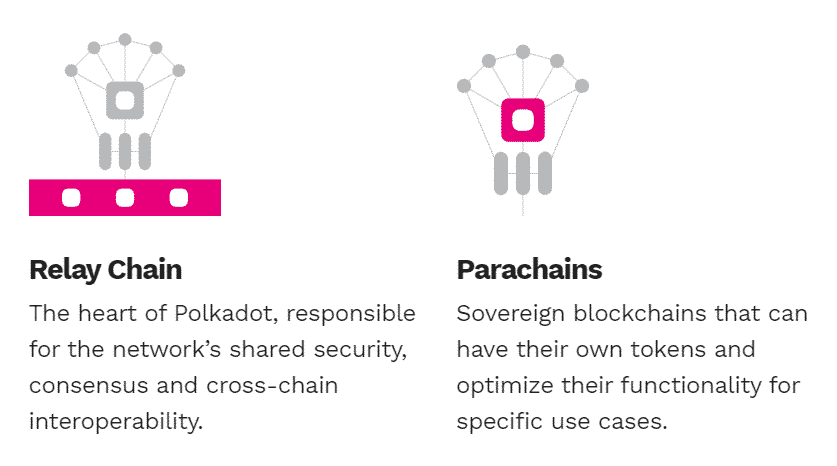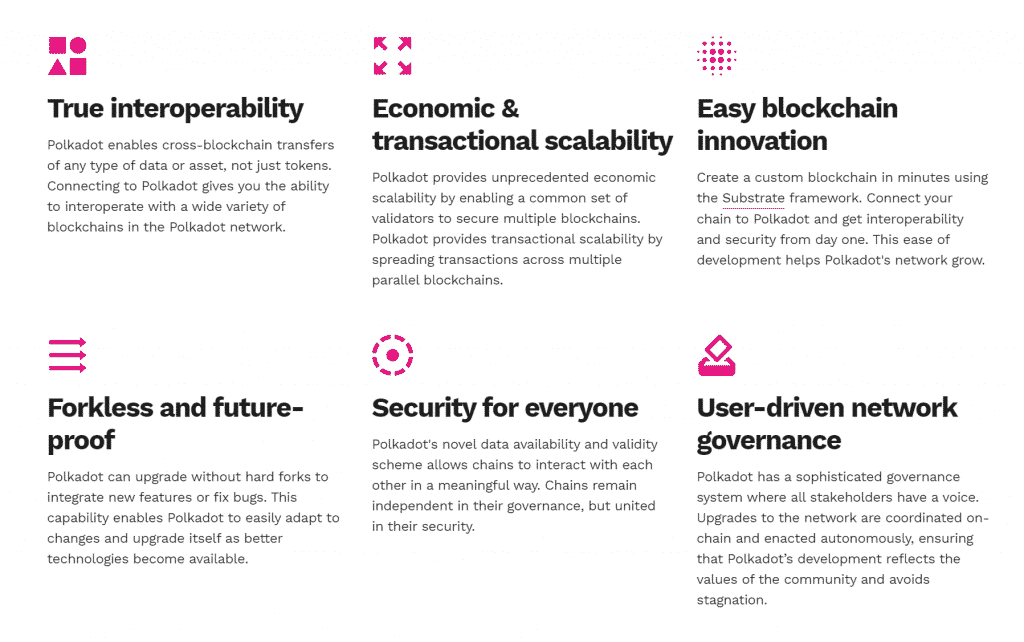Polkadot (DOT)
Last Updated on 8 April 2024 by CryptoTips.eu
The development of the Polkadot project began back in 2016. But since then, everything about this coin have been under the radar. However, in 2020, Polkadot has shaken up the crypto world with the finalization of its official release. The entire Polkadot project have been garnering a lot of attention from all ends.
Shortly after its launch, Polkadot has managed to join the top ten list of cryptos by market capitalization. Therefore, many controversies have been built around this coin, and some people even believe that Polkadot might be the Ethereum Killer cryptocurrency. All in all, the founder of Polkadot continues to insist that Polkadot is not a competitor of Ethereum.
But all logistics are straightforward that besides being a strong competitor, Polkadot can completely transform the crypto world as the mother of all blockchains. With Polkadot in the top ranks, we could be looking at a top-three market cap in just a few years. That said, let’s look at this comprehensive Polkadot review and what it has to offer the crypto market.
- Polkadot
(DOT) - Price $4.02
- Market Cap
$6.13 B

Polkadot (DOT)
More information
What is Polkadot?
 Polkadot provides a new type of blockchain that facilitates interoperability between independent blockchains. Polkadot simply seeks the power to decentralize the future of the internet. While interoperability is quite a popular concept within the blockchain ecosystems, it’s still something that has yet to be achieved and actualized in the crypto world.
Polkadot provides a new type of blockchain that facilitates interoperability between independent blockchains. Polkadot simply seeks the power to decentralize the future of the internet. While interoperability is quite a popular concept within the blockchain ecosystems, it’s still something that has yet to be achieved and actualized in the crypto world.
However, with Polkadot, we might be experiencing the very first interoperable blockchain platform soon enough. A concept that has been achieved in micro lab-based environments will now be not only achieved but also used in a broader scale.
The core operations of the blockchain will be pioneered by DOT, which is the native cryptocurrency of this platform. Polkadot has so much in common with the other smart contract platforms, for instance, Ethereum, only that it offers something more.
With Polkadot, we will have sharding, which is the ability to have chains within chains, while interoperability will be like the ability for one blockchain to speak to another blockchain. However, we will need fuel for the network to achieve seamless operations, and that’s where DOT comes in. It’s just the same way Ether acts as the lifeblood for Ethereum smart contracts.
How Does Polkadot Work?
There is no denying, Polkadot might be just the most complex cryptocurrencies we have in the crypto space at the moment. We could try and explain its technicalities in layman’s language, but the truth is, there is no way of doing that without touching on some very technical terms. And for that, kindly bear with me.
 But simply, Polkadot is more of an ecosystem of blockchains. The Relay chain is the core of the Polkadot ecosystem, while the parachains are the blockchains connected to the Relay chain. However, the parachains are completely independent with their own tokens, governance structures, and consensus mechanisms.
But simply, Polkadot is more of an ecosystem of blockchains. The Relay chain is the core of the Polkadot ecosystem, while the parachains are the blockchains connected to the Relay chain. However, the parachains are completely independent with their own tokens, governance structures, and consensus mechanisms.
This new design by Polkadot aims at helping blockchains communicate and pool their security within the network while still allowing them to have independent state-transition functions. With this, Polkadot opens the door to a wide range of blockchains network. Hence, consortium and private chains get firewalled from the public and open chains like Ethereum.
And the best part is that this is different from the internet synergy today, where private chains cannot communicate without losing their ability to communicate on individual terms.
Features of Polkadot
- Interoperability: Polkadot promotes interoperability by connecting all the different blockchains. With Polkadot, we can encourage unprecedented interoperability between the wide range of ecosystems.
- Scalability: Polkadot has a standard set of validators who can operate the wide range of blockchains that are connected through Polkadot. This is something that will exponentially increase the scalability of the blockchain.
- Improved Security: As we mentioned earlier, Polkadot introduces an incredible security feature where it allows chains to interact meaningfully with each other. And the best part being; they remain independent enough to run unique governance models.
- Facilitates Innovation: With the substrate network of Polkadot, you can create a custom blockchain with so much ease. This ease of blockchain development will encourage participation from more developers.
- Remove the need for Forks: Ethereum and Bitcoin can tell this better; forks only cause split up and havocs in the communities. But with Polkadot, there will be no more need for forks in order to fix bugs, integrate new features, and make necessary upgrades.
What Are the Governance Protocols of Polkadot?
Unlike most blockchains, Polkadot implements a version of proof of stake known as nominated proof of stake. This may be a little complicated for most people to understand, but there are a few pointers you can keep in mind to give you a better understanding.
- Validators on the blockchain get to secure the relay chain, and that’s by staking the DOT coins
- Validators also get to participate in the consensus process alongside other validators while validating the collator’s proof.
- The collators maintain parachains, and that’s by collating the parachain transactions from the users. They then send the proof of transactions made to validators.
- We also have the Nominators and Fishermen who are also active in the consensus system.
- The Nominators get to nominate useful validators and also stake the DOT tokens. This is crucial as it helps them to secure the relay chain even further.
- The Fishermen get the role of ensuring and promoting good behavior within the network. They will continuously monitor the ecosystem then prove bad behavior to validators. If the fishermen prove any misbehavior of a validator, they could lose part or all of their stake to the other validators in the network.

What is the Main Purpose of DOT Tokens in the Polkadot Network?
- Operations: In the Polkadot coin protocols, adequate maintenance of the consensus mechanism lays a vital role in the functioning of the Polkadot network. Therefore, DOT token holders must show active participation to avoid being punished for suboptimal behavior.
- Governance: DOT token holders get complete control over the Polkadot governance protocols. The token holders get a wide range of care functions such as protocol changes, additions, and removal of the parachains and determining the fee structures.
- Bonding: When validators stake DOT tokens to the new parachains, they get to receive active participation rewards.
Pros of DOT
Polkadot stands out among other cryptocurrencies for a straightforward fact. While other cryptos are trying to deliver something, Polkadot promises to build and launch a ship that’s already parked on the runway. Most of the existing blockchains like Ethereum have to try and deliver the promises it has made while the ship has already set sail.
And as we all know, it’s harder to upgrade an already existing blockchain. Changing the full functionalities of a blockchain is more challenging as compared to building that with a blockchain that’s being built from the ground up. That said, Polkadot has many advantages over its competitors as it has the time required to create these things before things go too far.
What’s more, after launch, Polkadot has enabled a whole new range of uses such as interoperability and sharding. This is something that will give room for horizontal sharding, something that Ethereum has failed to achieve.
With Ethereum, we can only achieve 30 transactions per second while, on the other hand, Polkadot can quickly achieve millions of transactions per second. With that in mind, Polkadot will now be able to handle every smart contract that has, over the years, slowed down Ethereum. With Polkadot, there will be no more high gas fees that tend to slow down the network.

Cons of DOT
Polkadot has a downside too, especially when it comes to gaining market share for the smart contract community, Polkadot has quite a hard time. Currently, there are many smart contracts platforms, and all of them are seeking attention in the crypto world. From Cardano to Ethereum, so Polkadot has quite a challenge.
Therefore, if Polkadot doesn’t prove that it has the future of smart contracts, it will be hard for the blockchain to thrive as anticipated after the launch. At the end of the day, Polkadot will end up being just another token that has risen due to hype and potential but didn’t deliver all the promises.
We could say that it’s still too early to determine the future of DOT. As we all know, the crypto market is very unpredictable, that we can hardly determine what the future will look like for DOT.
In Summary
Now, there you have it, some of the basic things you’d like to know about Polkadot. The incredible thing is how too good this project is, and this is just the beginning. But as we have seen from this article, Polkadot has some pretty unique features, making it one of the most well-thought-of projects in the crypto space.
Polkadot integrates some incredible underlying technology, making it the most captivating projects we currently have in the market. I bet everyone can’t wait to see what Polkadot can do for us crypto lovers in the future.
Navigation